As institutions continue to experience change and disruption across campus, improving training, flexibility, and cross-functional relationships and collaboration will be necessary to continue to adapt in the "new normal."
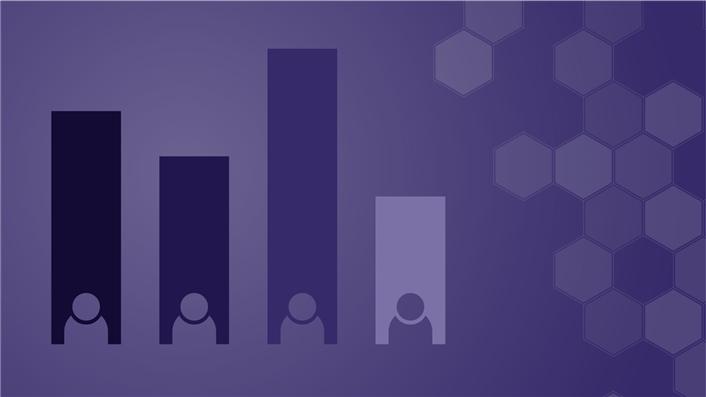
EDUCAUSE is helping institutional leaders, technology professionals, and other staff address their pressing challenges by sharing existing data and gathering new data from the higher education community. This report is based on an EDUCAUSE QuickPoll. QuickPolls enable us to rapidly gather, analyze, and share input from our community about specific emerging topics.Footnote1
The Challenge
Over the past several years colleges and universities have been called upon to rapidly adapt to the sudden changes and disruptions that have characterized pandemic-era higher education. While institutions have largely risen to the challenge and implemented wide-scale efforts to address these issues, it remains to be seen whether and where continued adaptations will be needed in higher education and whether institutions will, as a result of their efforts during the pandemic, be better prepared to meet future changes and disruptions. This QuickPoll is intended to gauge the current climate of change and disruption in higher education and institutions' readiness for future changes and disruptions.
The Bottom Line
Respondents are less certain about their institution's ability to adapt to change or disruption than they are about their own department/unit's ability. Technology leaders and colleagues seek increased cross-functional collaboration to further their individual and institutional capability to adapt to change or disruption, and they are also viewed as strong partners in enabling others to adapt to change. Professionals and staff will need training and support from faculty, leaders, and executives to improve and maintain their ability to adapt, just as employees across departments and levels will need to increase flexibility to effectively meet future change and disruption.
The Data: Current State of Change and Disruption
Although things are stabilizing, change and disruption continue. When asked to consider their institution's current climate with respect to change and/or disruption, a majority of respondents (69%) indicated that their institution continues to experience either "a great deal" (23%) or "some" (46%) change and/or disruption. Nearly one-third (31%) reported experiencing "minimal" change and/or disruption (see figure 1).
Thinking about the change and disruption higher education has experienced since the onset of the pandemic, which of the following best describes your institution's current climate?
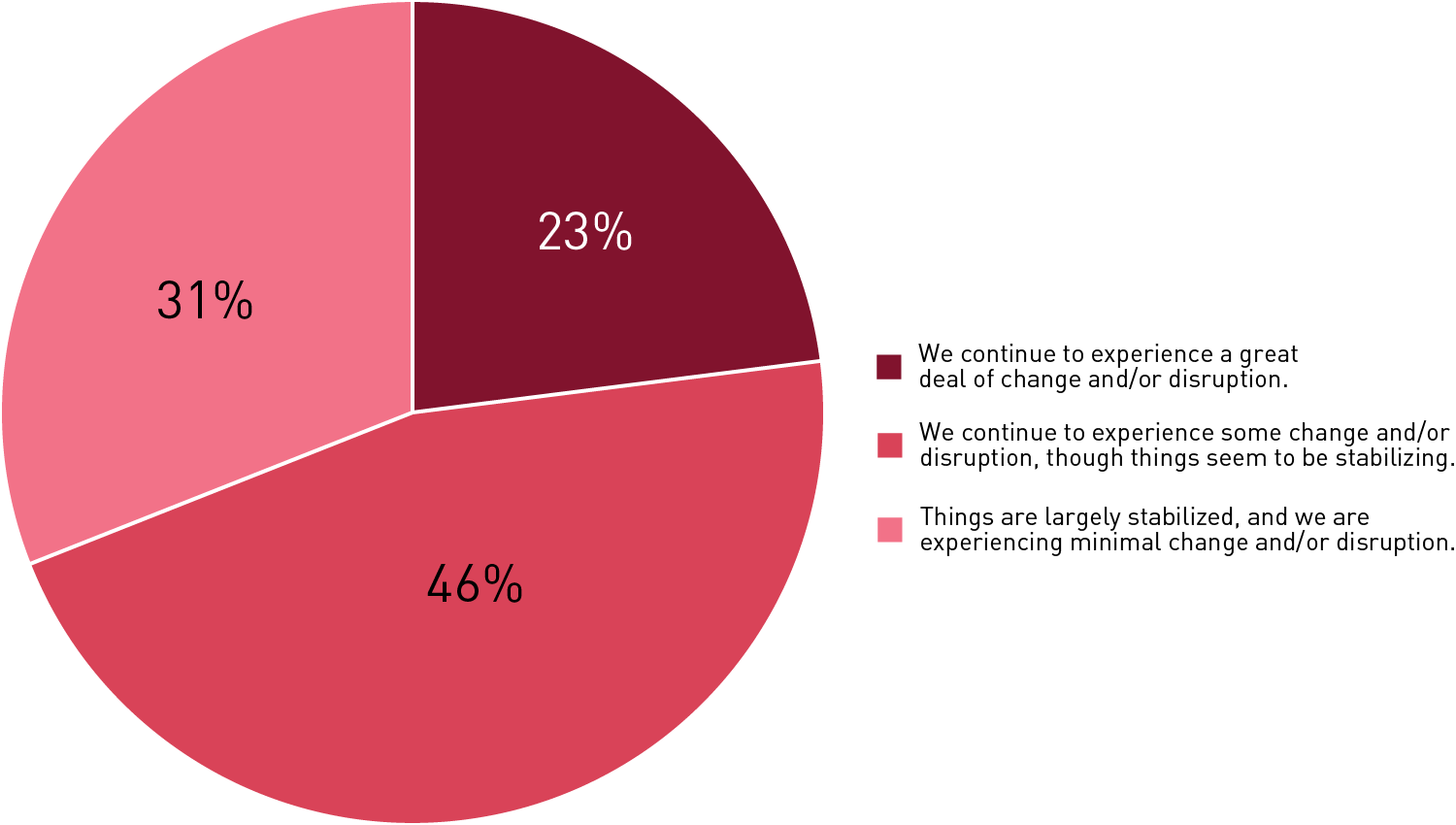
When comparing responses across workstreams, respondents whose primary department or area of responsibility is cybersecurity/privacy or network/infrastructure were more likely to report that they are experiencing minimal change and/or disruption (52% and 45%, respectively) as compared to other departments.
| Department or Area | Percentage Reporting Minimal Change and/or Disruption |
|---|---|
|
Cybersecurity/privacy |
52% |
|
Network/infrastructure |
45% |
|
Enterprise systems |
38% |
|
Information technology |
34% |
|
Data and analytics |
32% |
|
User support |
24% |
|
Teaching and learning |
23% |
|
Other |
20% |
|
Average |
31% |
Areas of change and disruption are found across institutions. Respondents who reported that their institution is still experiencing "a great deal" or "some" change and/or disruption (n = 366, 69%) were asked to identify the primary areas of change or disruption their institution is still experiencing, and more than 300 respondents identified specific areas (n = 309). The areas most frequently cited were staffing (26%), operations (24%), work location (23%), technology (21%), course planning (20%), and enrollment (18%) (see figure 2).
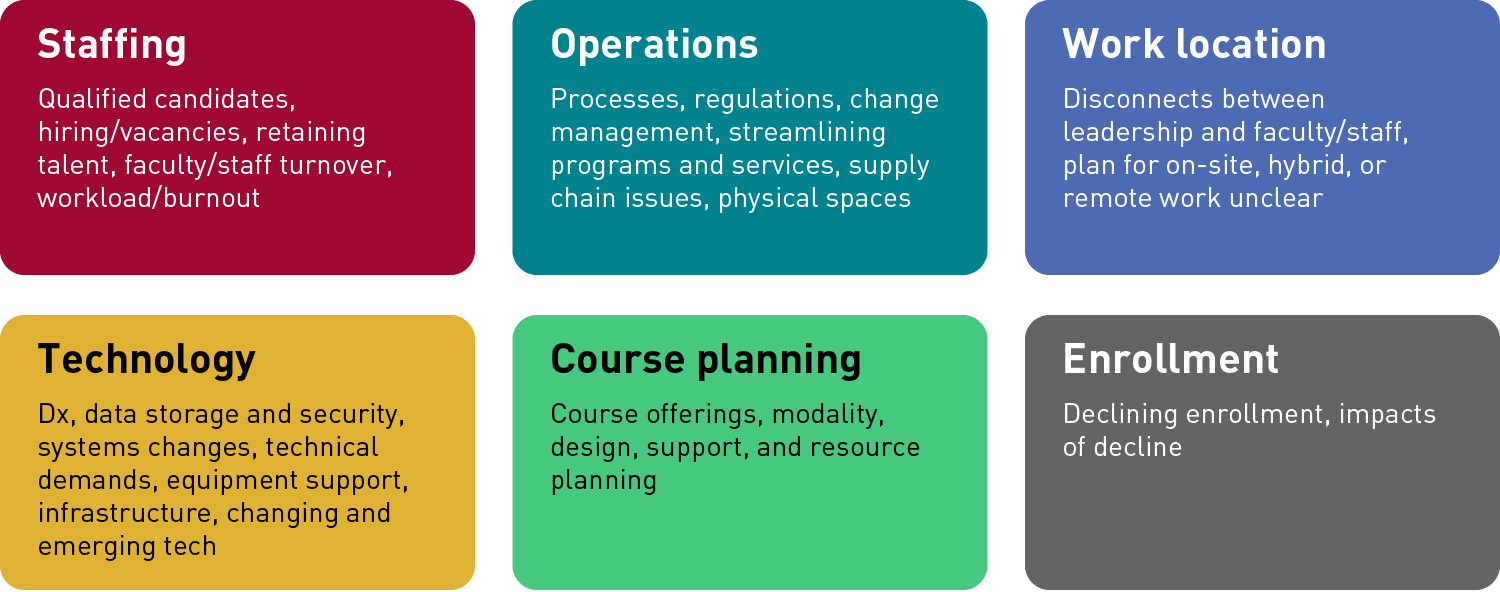
Hiring and retention issues were a common thread across many of the reported areas of change or disruption. Changes or disruptions in staffing have increased burnout and turnover, which has increased disruption to operations and budget. Increased technology demands and services, and the increase in remote and hybrid courses and work environments, are also being impacted by staffing issues, in addition to course planning and meeting a myriad of student needs (see figure 3).
What are the primary areas of change or disruption your institution is still experiencing?
In addition to the most frequently cited categories, other areas of change or disruption still being experienced by institutions include budget/financial; student needs (e.g., accessibility, expectations, learning styles, and mental health); leadership changes; academic integrity and the use of artificial intelligence; engagement and morale of students, faculty, and staff; and health safety/concerns.
The Data: Readiness for Future Change and Disruption
Respondents are uncertain whether their institution is ready to adapt to change. Asked if their institution is capable of adapting to rapid change or disruption, about a quarter of respondents (26%) said yes, and one in ten (11%) said no. A majority of respondents were more equivocal, with 62% indicating that their institution is "somewhat" capable of adapting to rapid change or disruption.
Overall, respondents were nearly equally split into three groups on whether readiness to adapt to change or disruption is a component of their institution's strategic plan. Slightly more than one-third (35%) understand this to be part of their strategic plan, 29% reported that it is not a component of their strategic plan, and 36% indicated that they do not know. Among those who do not know whether their strategic plan addresses institutional readiness to adapt to change or disruption, results differed directionally by respondent position/role: professional/staff (54%) were much more likely to say they do not know than were directors, executives, or C-level respondents (28%, 10%, and 11%, respectively).
Readiness to adapt may be stronger at the departmental level. Regarding the capability of their department to adapt to new and unexpected situations, most respondents (57%) indicated that it would be "easy" (51%) or "very easy" (6%) for their department/unit to do so. Slightly more than one-third (35%) indicated that it would be "difficult" (32%) or "very difficult" (3%), and 8% reported that they do not know. In contrast to the generally neutral perception about institutional capability to adapt to change and/or disruption, respondents appear to be more certain about their department/unit's adaptability.
When asked about the extent to which various institutional partners have enabled their department/unit to adapt to rapidly changing circumstances (see figure 4), an overwhelming majority of respondents rated technology unit leaders (92%) and technology unit colleagues (92%) as strong partners to a "great" or "moderate" extent, followed by academic units (67%), president or chancellor (64%), and business units (64%).
To what extent have the following areas been strong partners in enabling your department/unit to adapt to rapidly changing circumstances?
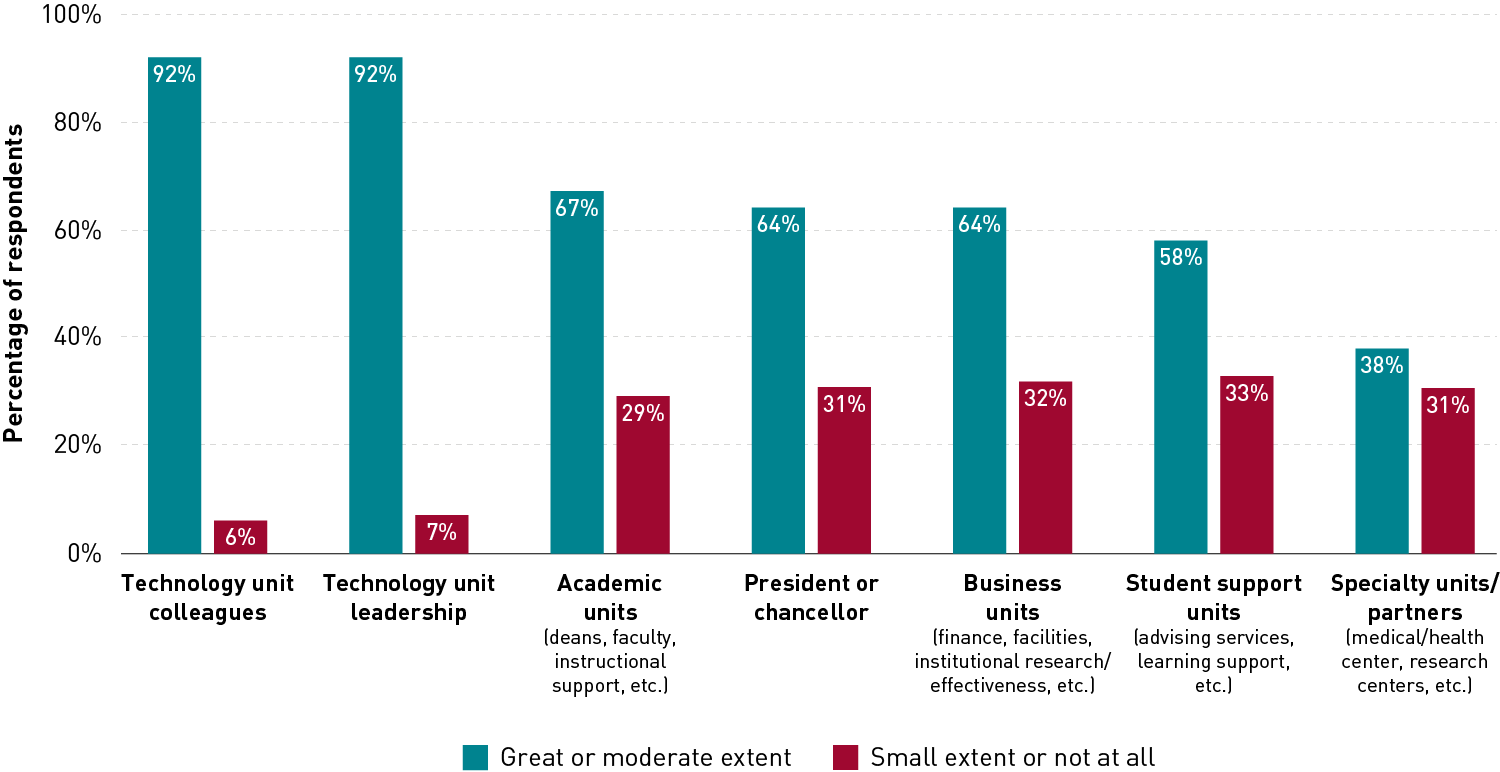
The Data: Challenges and Opportunities for Adaptability
Institutional changes or disruptions influence personal adaptability challenges. Reflecting several of the primary areas of change or disruption institutions continue to experience, respondents reported budget (65%), staffing (65%), faculty resistance to change (56%), and policies or bureaucratic barriers (45%) as the top challenges that have affected their personal ability to adapt to rapid change or disruption (see figure 5). Declining enrollments have negatively impacted budgets, staffing disruptions have affected various areas across campus, and changes in business operations and course planning remain in flux, which may be viewed as barriers to moving forward.
What challenges, if any, have affected your own ability to adapt to rapid change or disruption? (Select all that apply.)
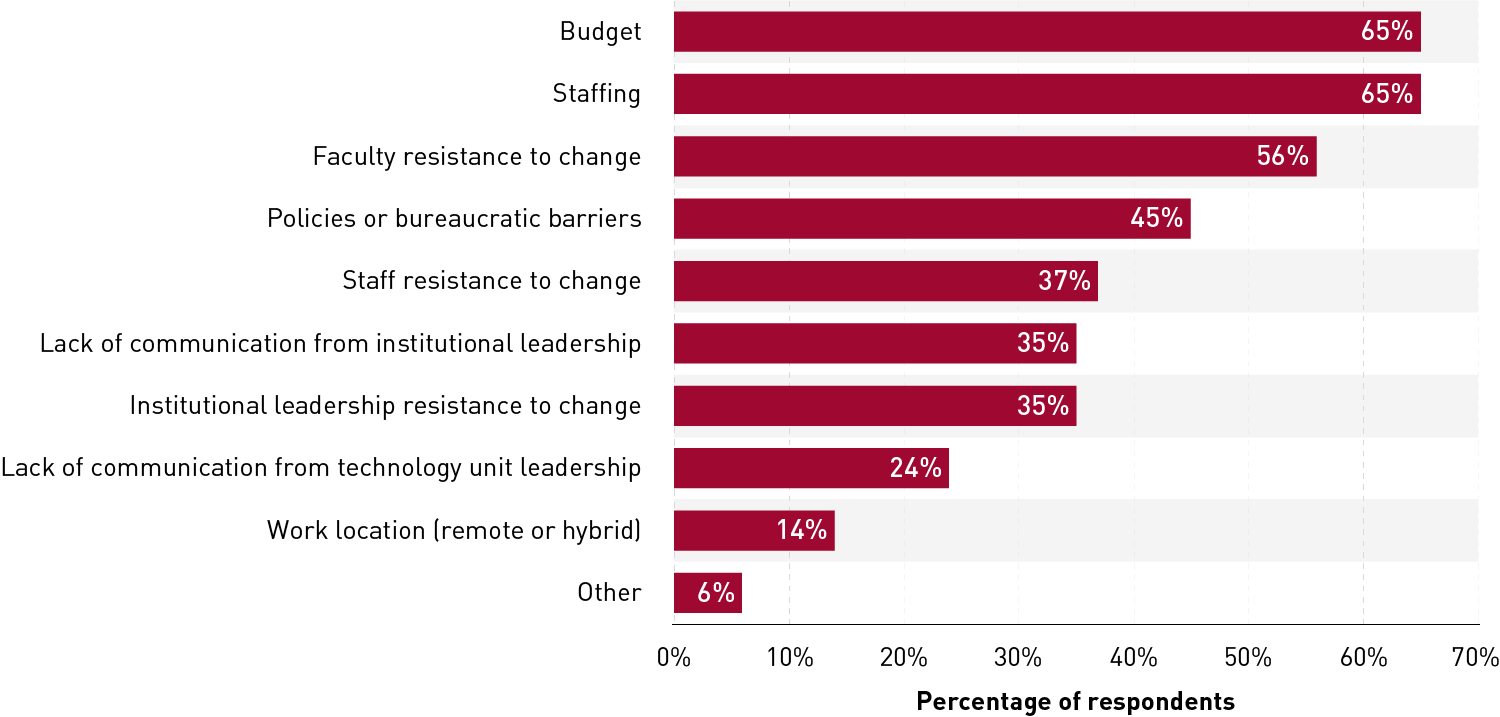
Student-centered Dx efforts are strategic opportunities. Managers, directors, executives/VP/SVPs, and c-level respondents were asked in what ways they are exploring the benefits of digital transformation (Dx) in support of new strategic opportunities for their institution. Forty-four percent (44%) responded to this open-ended question, and four categories emerged as the most frequently cited: technologies (e.g., tools, systems), process review and automation, academic and student-facing services, and business operations and student support units.
Many comments referenced the benefits to, impacts on, or experiences of students as the focus of or reason for the Dx effort, such as "delivering educational software through virtualized technology and automation," "improving the student experience and learning outcomes with the use of virtual assistants," and "curriculum and course-level redesigns to support a greater range of flexibility for learners and expanding capabilities of learning spaces to support [a] broader range of options for instructors and students."
Additional ways that institutions are exploring the benefits of digital transformation in support of new strategic opportunities focused on data access, analytics, and governance; supporting a remote workforce; and augmented or virtual reality and artificial intelligence (AI).
Improving training, flexibility, and relationships will enable adaptability in the "new normal." To progress from the current state to a future state, what changes or improvements are needed to meet the strategic opportunities teams are exploring in this "new normal" way of work? The top four changes or improvements selected to help meet these strategic opportunities are increasing staff development/training (62%), increasing flexibility with where and how work is completed (59%), hiring additional staff (53%), and deepening connections between institutional partners and the technology unit (53%). While approximately half of respondents identified continuous improvement practices (50%) and risk management (48%) as needed changes or improvements, just one-third believe that scenario planning (33%) and developing front-line staff for more strategic roles/tasks (32%) are necessary to meet strategic opportunities (see figure 6).
What changes or improvements are needed to meet the strategic opportunities your team may be exploring in this "new normal" way of work? (Select all that apply.)
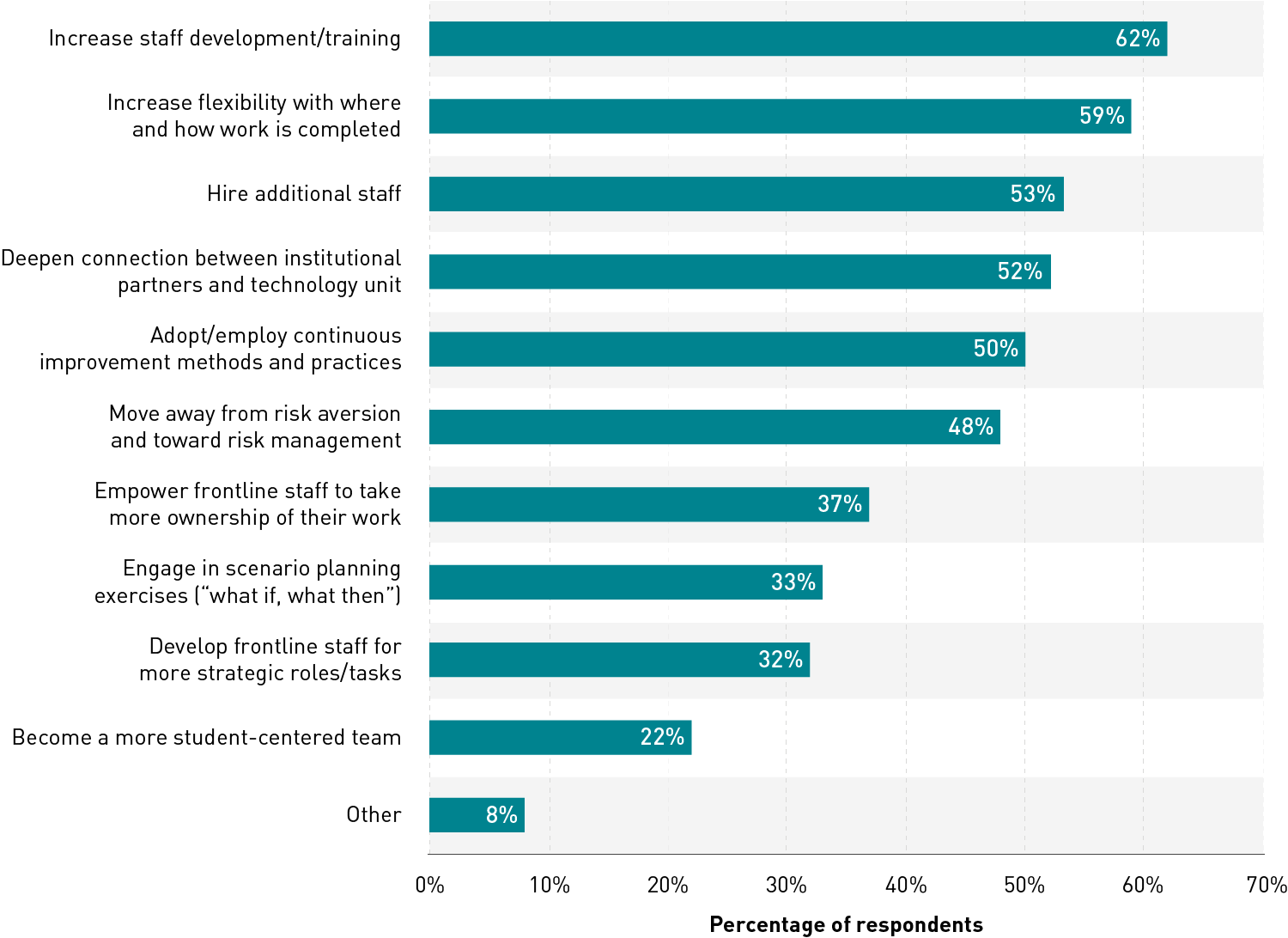
Professionals need soft skills development as much as technical competency. Respondents in professional/staff roles were asked to describe what new skills or competencies they will need to support their ability to continue to adapt to change. Sixty-four technology professionals (35%) highlighted four primary areas where they need support in developing new skills or competencies regarding their adaptability: soft skills, technical skills, institutional operations and collaboration, and flexible work and associated impacts.
To continue to adapt to change, technology professionals reported the need for soft-skills development in a variety of areas, such as managing change, conflict, time, projects, and resources, as well as relationship-building and communication:
"I think skills that support healthier time management and prioritizing would be a significant benefit so I don't burn out."
Regarding technical skills and competencies, professionals identified needed training on new technologies, systems, applications, artificial intelligence/ChatGTP, and automation:
"How to use AI to speed up my own work and to help faculty do the same while teaching students how to make it work for them."
Technology professionals also identified the need for increased knowledge and understanding of institutional operations and an increase in cross-functional collaboration:
"Ability to work with business and departmental units to understand how we can better engage and position ourselves to be able to deliver consistent services based on their strategic goals."
Impacts associated with flexible work locations and how to manage their mental health and work/life balance while working remotely are also skills that professionals are seeking in support of their ability to adapt:
"I think the new normal can still cause a lot of stress (not seeing colleagues in-person, home/work life encroaching on each other), and it's important to be able to recognize it in yourself and others so you can better support one another."
Common Challenges
- Readiness to adapt to future change is uncertain. Most respondents perceive their institution as only "somewhat" capable of adapting to rapid change or disruption, where readiness to adapt at the department level may be stronger.
- Challenges with adapting to change are mostly beyond employees' control. Minimizing the challenges employees face with adapting to change (e.g., budget, policies, culture) is not dependent on employees' ability to adapt but rather on institutions' response to and management of these challenges.
- Change and disruption go beyond staffing challenges. While institutions that continue to experience change and disruption are certainly facing staffing challenges, they are also experiencing change and/or disruption in operations, work location, technology, course planning, and enrollment.
- Opportunities to adapt are challenging. Accommodating and designing flexible environments is well under way, yet the desire for flexible work location (and course modalities) continues to pose a challenge to course planning, technology resources, and professionals who are dealing with how to establish healthy work/life balances. Institutions are also trying to find the right balance to meet student, faculty, and staff needs, all while facing faculty and staff turnover and lower enrollments.
Promising Practices
- Lean into departments/units. Most of the reported changes or disruptions affect areas across the institution. Recognizing how these broader changes (e.g., staffing, course planning, work location, enrollment) impact the department/unit level, and understanding how to best support professionals and staff in adapting to these changes (e.g., soft-skills training), can underpin cohesive, institution-wide efforts already in progress to increase adaptability.
- Bring technology professionals along in the journey. The gap between professionals/staff and senior leaders who are unaware of institutional readiness planning to address adaptability is quite stark. Professionals were clear when asked what skills and competencies they need to continue to adapt, which included understanding institutional operations (such as readiness planning as part of the strategic plan) and collaborating across the institution, not just within their immediate areas or functional units.
- Increase cross-functional collaboration. Deepening connections between technology units and institutional partners addresses one of the top changes or improvements identified as necessary to support continued adaptability. This also meets professional development needs and is an opportunity to improve enablement of department/unit adaptability.
- Change or improve training, flexible work. Addressing the soft skills and technical competencies that professionals and staff require, and increasing flexibility with where and how work is completed, will enable employees to continue adapting to change in the "new normal" way of work and may also reduce the uncertainty surrounding whether their institution is capable of adapting.
All QuickPoll results can be found on the EDUCAUSE QuickPolls web page. For more information and analysis about higher education IT research and data, please visit the EDUCAUSE Review EDUCAUSE Research Notes topic channel, as well as the EDUCAUSE Research web page.
Note
- QuickPolls are less formal than EDUCAUSE survey research. They gather data in a single day or two, instead of over several weeks, and allow timely reporting of current issues. This poll was conducted on January 9–10, 2023, consisted of 16 questions, and resulted in 535 complete responses. Poll invitations were sent to participants through the EDUCAUSE Connect platform to groups focused on technology and IT leadership and management, cybersecurity and privacy, and teaching and learning. We are not able to associate responses with specific institutions. Our sample represents a range of institution types and FTE sizes, and most respondents (90%) represented U.S. institutions. Jump back to footnote 1 in the text.
Ashley Caron is Researcher at EDUCAUSE.
© 2023 Ashley Caron. The text of this work is licensed under a Creative Commons BY-NC-ND 4.0 International License.
